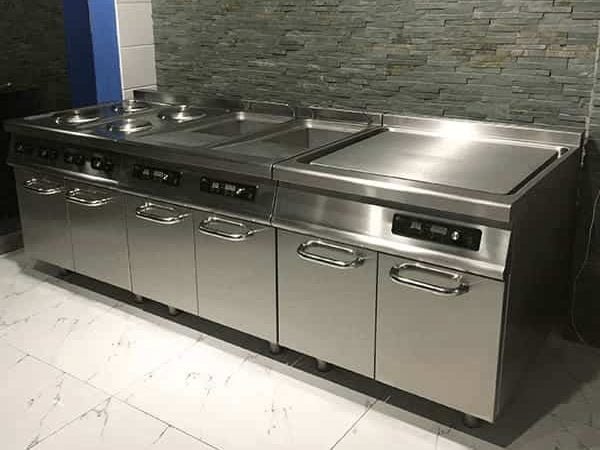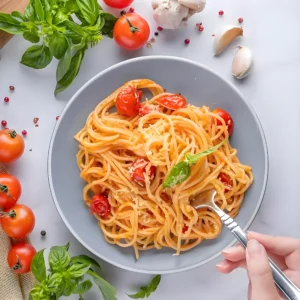Teppanyaki is a cooking method. First heat the iron plate, immediately place fresh meat and vegetables on it, cover it, and eat.
Teppanyaki was invented in Spain in the 15th and 16th centuries. At that time, because Spain had developed shipping, it often sailed and colonized all over the world. Because the crews were with the sea all day long, life at sea was very boring, so they had to fish for fun all day long. Grilling fish until the skin is fragrant and the meat is cooked. The Spaniards later spread this cooking method to Mexico and the United States on the American continent. It was not until the early 20th century that a Japanese-American introduced this iron plate cooking method. The cooking technology of cooked food was introduced to Japan and improved to become the famous Japanese Teppanyaki today.
Origin
Teppanyaki is a type of Japanese high-end cuisine.
Teppanyaki is very popular in Japan, but there are also Korean-style barbecues, which the Japanese call Yakiniku (roasted meat), and Japanese-style Teppanyaki (Okonomiyaki). Japanese Teppanyaki is at a higher level than traditional Japanese cuisine. Even in Japan, many people don’t frequent it. Treating guests to it is already a great courtesy. The reason is that Teppanyaki uses the finest ingredients, such as fresh seafood, including lobster, scallops, abalone, etc. At the same time, the ingredients are not marinated before production, and only two condiments, salt, and pepper, are added during the grilling process to enjoy the original taste of the food. The materials have different levels. Taking beef as an example, there are domestic beef, American beef, and Kobe beef. The price difference is also quite large. Kobe beef costs more than 700 yuan per serving. There are many famous teppanyaki suppliers in China, and there are also many Specialty Teppa
Process Status
Since Teppanyaki entered China in the 1980s, it has been presented in the form of high-end dining, mainly in star hotels and high-end restaurants. In recent years, it has also entered the general market.
Type
Japanese Teppanyaki
Japanese Teppanyaki is the highest level of dining in Japanese cuisine. It is different from Chinese barbecue and Korean barbecue. Eating Japanese Teppanyaki is a symbol of wealth and status (and it is just a symbol). Teppanyaki grills and matures ingredients directly on a hot iron plate. These ingredients cannot be marinated and processed in advance. Instead, they are quickly cooked and matured on a high-heat iron plate to retain their nutrition and taste. Since the ingredients cannot be marinated and processed in advance, the requirements for raw materials are quite high, such as sirloin beef, filet mignon, beef ribs, cod, scallops, foie gras, etc.

Beijing Teppanyaki
Compared with Japanese Teppanyaki, Beijing Teppanyaki has made two main improvements. On the one hand, there are changes in ingredients. Japanese Teppanyaki does not use high-end raw materials, so the cost is high. Now Teppanyaki chefs are using their brains to move many Chinese ingredients to the iron plate for cooking. Such as chicken wings, chicken, bacon rolls, pork neck, lamb, lamb rolls, fatty beef, fatty beef rolls, etc. Vegetables such as asparagus, white mushrooms, cabbage, cabbage, mushrooms, drumstick mushrooms, green peppers, etc. Seafood such as scallops, mussels, anchovies, prawns, squid rings, etc. Staple foods include rice, fried noodles, etc., all of which can be fried on an iron plate.
Teppanyaki chefs use multi-flavored seasonings such as umami juice, soy sauce, seafood soy sauce, and brandy into the Teppanyaki ingredients to create a richer taste.

French Teppanyaki
Teppanyaki is a combination of taste and vision. It is a distinguished dining experience. It changes the traditional cooking form. It is made on-site with the iron plate as the stage and the knives and shovels as props; all its raw materials will be cooked in front of your eyes. , cook delicious food exclusive to your taste, allowing guests to experience aristocratic dining enjoyment.

Fancy Teppanyaki
Fancy Teppanyaki combines the strengths of various schools of Teppanyaki and innovates traditional Japanese Teppanyaki into Fancy Teppanyaki. The restaurant moves the kitchen of the French feast to the iron plate. From cutting, matching, plating, decoration and all French cooking techniques, it is displayed in front of you, integrating French cooking techniques with traditional Chinese art, and the serving process It is also the style of a French meal, including aperitifs, appetizers, soups, main courses, desserts, fruits, etc. With the swing of the chef’s shovel, everything changes from lively to delicious. This is the charm of Teppanyaki.

Korean Teppanyaki
Korean Teppanyaki is mainly beef. Beef tenderloin, steak, beef tongue, sirloin, seafood, sashimi, etc. are all Korean barbecue delicacies. Grilled beef tenderloin and grilled steak are the most famous. The meat is delicious and tender, and everyone who tastes it will talk about it. This is because every Korean restaurant attaches great importance to the selection of ingredients, and the beef used in many Korean restaurants comes from specialized meat companies. According to the different parts of meat required, the feeds eaten by the beef cattle here also have different formulas. It is said that when some cows are being raised, they have to drink beer, listen to music, and receive special massages daily. Whether this is indeed the case is unknown. However, the strict selection of Korean barbecue ingredients is true.
The meat in Korean Teppanyaki is not simmered in advance, and its flavor mainly comes from the juice in which it is dipped. Different barbecues require different juices. If you eat bacon, you will have bacon juice; if you eat barbecue, you will have barbecue juice… , each juice is carefully prepared from more than a dozen kinds of seasonings (all kinds of seasonings can be bought in the market). It is said that these sweet and sour, fresh and refreshing juices with subtle differences are how to make them. Only the head chef knew it. There is also a kind of sauce in the condiment, which has a rather strange taste, but after trying it, it is quite mellow and makes people like Beijing stinky tofu.

Production Method
Preparation Phase
- Choose a better piece of grilled meat or other meat, such as chicken, duck kidney, fresh squid, etc.;
- Appropriate amount of ginger and green pepper;
- Appropriate amount of oil, salt, and soy sauce.
Teppanyaki usually uses high-end, fresh ingredients, mainly including seafood such as lobster, prawns, scallops, abalone, etc., meat such as Wagyu beef and chicken produced in Japan, vegetables such as fungi, and even tofu, etc.; some restaurants provide Such as enoki mushrooms or peeled chili beef rolls and other ways to eat. Many Japanese Teppanyaki menus also include fried rice or noodles.
production stage
Heat the iron plate, add a little oil, put the meat, ginger, and green pepper on it, cover it, and let it cook for a while. When it’s almost ready, add soy sauce and sprinkle with chopped green onion at the end.
Equipment
- Teppanyaki equipment? Large-scale teppanyaki equipment can cook Japanese teppanyaki, French teppanyaki, French teppanyaki, Japanese teppanyaki, Western food, and fancy teppanyaki according to the characteristics.
- Snack Teppanyaki? The snack Teppanyaki can be operated by one or two people, and the equipment is a Teppanyaki snack cart. Commonly cooked foods include Teppanyaki squid, Teppanyaki tenderloin, etc. on the streets or in crowded places.

-
 Teppanyaki biftek ?zgara makinesi-Ticari Kalbur için Elektrikli Dökme Demir Aral???
Teppanyaki biftek ?zgara makinesi-Ticari Kalbur için Elektrikli Dökme Demir Aral??? -
 Ticari kalbur ?zgara-Asadores Parrilla Electrica düz Gaz / ?ndüksiyon Elektrikli kalbur
Ticari kalbur ?zgara-Asadores Parrilla Electrica düz Gaz / ?ndüksiyon Elektrikli kalbur -
 Teppanyaki indüksiyon elektrikli ?zgaralar – Restoranlar için Tezgah Üstü biftek ?zgara makinesi
Teppanyaki indüksiyon elektrikli ?zgaralar – Restoranlar için Tezgah Üstü biftek ?zgara makinesi -
 Teppanyaki Izgara Biftek Makinesi - Izgara için Restoran Elektrikli ?ndüksiyon Kalbur
Teppanyaki Izgara Biftek Makinesi - Izgara için Restoran Elektrikli ?ndüksiyon Kalbur
Main Ingredients
A. Large prawns:
Main origin: Southeast Asia, Vietnam, also known as long-bearded male and tiger-headed male.
Nutritional value: 18.6g of protein, 62g of calcium, fat, carbohydrates, multiple vitamins and minerals, and rich in vitamin E and iodine.
B. Sea crab:
Main origin: coastal countries of the world
Nutritional value: It is rich in protein, trace elements and other nutrients. It has the functions of clearing away heat and detoxifying, nourishing essence and activating blood, and replenishing bones and marrow.
C. Abalone:
Main places of origin:
Nutritional value: Abalone has extremely high nutritional value and is rich in globulin. It has the effect of nourishing yin and replenishing yang. The meat of abalone also contains a component called “baosin” for short, which has the necessary metabolic substances to destroy cancer cells. , is a better anti-cancer food.
D. Fresh squid:
Main places of origin:
Nutritional value: Squid is rich in calcium, phosphorus, iron and other nutrients, which is very beneficial to the development of human bones and hematopoietic function. It can prevent the occurrence of anemia, relieve fatigue, restore vision, and improve liver function.
E. Fresh eel:
Nutritional value: divided into two types: river eel and conger eel; eel is rich in fat and carbohydrates, ranking first among all fish; gray eel is also called white eel, and its fat and cholesterol content are also high. The fat of conger eel The content of eel and cholesterol is low. Eel has the functions of nourishing and strengthening, dispelling wind and killing insects, nourishing deficiency and nourishing blood, and anti-fatigue. The eel contains a rare substance called Xihe Locke, and the protein has many It has the effect of strengthening essence and nourishing kidneys, and is the best health food for young couples, middle-aged and elderly people.
F. Silver cod:
Main producing areas: Cod is produced in Alaska, Canada and Iceland.
Nutritional value: It is a high-protein and low-fat healthy food. It contains a large amount of inorganic salts and iodine. It has the effects of activating blood circulation and removing blood clots, nourishing blood and reducing swelling.
G. Salmon:
Main producing areas: Norway, Russia, Chile, and my country’s Heilongjiang border. Most of them are farmed salmon. Wild salmon are longer than farmed salmon. The back bones of farmed salmon have traces of being hit by lasers.
Nutritional value: Freshwater fish, salmon, and trout have similar living habits. The suitable temperatures are 7-20°C and 10-18°C. Norwegian salmon is produced in the Atlantic Ocean and is rich in vitamins A, B, B2, B3, B6, B12, E, D protein, amino acids and unsaturated fatty acids.
H. Flat fish:
Main places of origin:
Nutritional value: The scientific name is pomfret, also known as mirror fish and flat pomfret; there are two types: silver pomfret and gray pomfret; it also has the nutritional characteristics of marine fish, rich in high protein, unsaturated fatty acids and polypeptides. trace elements.
I. Scallops:
Main producing areas: Scallops are mainly produced in Australia, and are now cultured in Dalian and Qingdao in my country. They are composed of scallops and shell pillars. Those with red scallops are female scallops, and those without scallops are male scallops.
Nutritional value: Rich in amino acids, proteins, carbohydrates, vitamins, inorganic salts, unsaturated fatty acids (EPA, DHA) and trace elements, shellfish has the effect of nourishing yin, nourishing the kidneys and regulating the body.
J. Tuna:
Main origin: Japan and Taiwan are the main fishing areas. Blue dorsal fin is the best. It is produced in the Atlantic Ocean, far away from the offshore sea and grows in pollution-free deep sea waters.
Nutritional value: Protein is as high as 90%, contains a large amount of inorganic salts and carbohydrates, and has high content of EPA, DHA and unsaturated fatty acids (DHA refers to brain gold, EPA refers to prostate)
K. Foie gras:
Main place of origin: France. It is a specialty of France. It has now been introduced to Weihai and Jilin Provinces in China. Its scientific name is Lande goose. It stops eating twenty days before slaughter and undergoes hormone force-feeding. The purpose is to Livers are bled during slaughter.
Nutritional value: Foie gras is known as one of the three most delicious foods in the world. It is also rich in carbohydrates and protein. Long-term consumption can promote the expansion and contraction of blood vessels, achieve the effect of evolving blood and preventing blood clots.
L. Beef:
Main place of production: Good beef is mainly produced in Japan. This is mainly because Japan has a small land area and does not have many places for stocking. Their country is relatively environmentally friendly, pays attention to technological updates, and pursues perfect breeding methods. Most of them The time is spent in captivity. During the process of freeing, pagers are hung on the ears for contro





